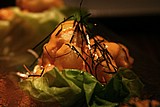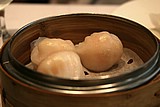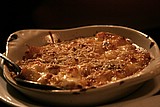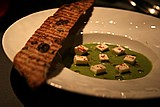Home |
Restaurants by City
|
Food Photography |
Archive | Philosophy |
![]()
Right now we are eating in Seattle, Washington.
|
Tuesday
2006
Permalink
|
Shibuya, Las Vegas, Nevada, Tasted on June 11, 2006 Periodically I have to explain how I judge eating experiences in Las Vegas. Authenticity (in the broadest sense) and flavor are pretty much all that count for me. But I admit that location does matter. I can go on all day that no noodle shop in the United States can compare to the best you can get in Tokyo. But if you can't get to Tokyo that kind of bar simply isn't helpful. There's a balance to strike of course. Just because a noodle shop is the best in Chicago (for example) doesn't mean it's great (or even good). So, here at tastingmenu, in our own admittedly subjective fashion we try to acknowledge that location (or rather proximity more accurately) is a factor. So when it comes to Vegas, given that you're surrounded by desert, proximity is key. And Las Vegas is a hub for manufactured experiences. Authenticity here has a different connotation (in my opinion). This is not to say that superficial food as fashion should be rewarded with our attention and appetites. But we should also not expect that even some of the best food on the strip will have the depth and love applied as (typically) only an independent venture can provide. What it might have is a focus on great flavor. With all that preamble and babbling, let's move on to the evening's destination... Shibuya at the MGM Grand. Shibuya is basically a Nobu style Japanese restaurant with a very cool super hip Japanese modern design. Many of the classic Nobu dishes are there with slight variation including Rock Shrimp Tempura with Butter Lettuce Wrap and Spicy Aioli, a little sloppy but the spiciness and the yuzu were fantastic, the delicious Toro with Garlic Chip, and the Miso Black Cod which came as part of the Salmon and Black Cod with Pineapple Miso Marinated Salmon and Shiro Miso Broiled Black Cod. Both pieces of fish were juicy and flaky. And unlike many places, the salmon was not overcooked. The reductions on top were nice and I enjoyed the cool pickled red colored scallion. We had started the meal with Lobster Miso Soup with Maitake Mushrooms and (what else?) Lobster. It had original flavor with big lobster chunks. The flavor was mild at first then building slowly to a slight pointed peppery kick on the finish. Enjoyable. The Kumamoto Oysters with Green Apple Ponzu and Momiji were perfect and fresh. Another interesting dish was the Kanpachi with Fresh Yuzu and Truffle Oil. The truffle gave the thick slabs of kanpachi a unique flavor. The Braised Kobe Short Rib and Seared Foie Gras with Spicy Sweet Soy had great flavor. The foie was "beautiful" according to Debbie. Great flavor, tender and flaky. As for the staples, the Tempura was fresh and light. Excellent. Kira pointed out that it was cool that they did Japanese vegetables: shiseido peppers, shiso, enoki mushrooms, etc. That said. Tempura should be served instantly. Always. The window for perfection is very small. As for the sushi we got a nice lobster roll that had some unique flavor but the rest was just ok (much like many of our Nobu experiences interestingly). Of course I will always prefer a slightly less manufactured experience. It's possible to detect authenticity through coherence across dishes as well as consistency across visits. But even in the culinary amusement park that is Las Vegas there's nothing wrong with enjoying food that is fresh, with great ingredients, and lots of flavor. Overall the meal was quite enjoyable. ∞ I debated whether to include this addendum to the writeup of Shibuya and decided I should. As I walked out of the restaurant I took a few photos of the environment. If I like a meal I do this at the end to give readers a sense of the physical experience of the restaurant. And this was especially key for such a cool looking restaurant as Shibuya. There are definitely a handful of restaurants that think their design or cooking is some unbelievable rocket science get a little nutty when you take pictures of their food and restaurant. I guess they imagine that competitors will pore over these images replicating their success and stealing their business. Of course, if the culinary experience you've created comes from inside you, no amount of photocopying will let people steal your success. My point is, while I think it's silly I do understand that some people don't want you taking pictures. At Shibuya I had already taken photos of the entire meal and was shooting a couple of shots of the cool video wall (blue and green) behind the sushi bar. As I took my last shot I hear a voice coming from my right saying "no pictures allowed". Before I have a chance to lower my camera I get hit on the arm shoving me. Needless to say, I don't care if I took a picture of the recipe for their super secret miso soup, there's no need to touch me. Of course it was just a shove and I wasn't hurt. I just think it's unbelievable that someone working in the service industry would touch a customer (unless the customer was being violent). Needless to say I got incredibly pissed. I told the guy not to touch me repeatedly until the other staff member next to him finally apologized on this guy's behalf. The violent asshole that hit my arm just stood there with a shit eating grin on his face. Needless to say we got out of there quickly. But the more I thought about it, the more angry I got. Ultimately I got mostly angry at myself for not snapping a picture of this jerk and getting his name. I don't believe in trying to get people fired. Even jerks like this need to make a living. However, I do think that the proprietors of Shibuya should wonder about their hiring practices, understand how this person treats customers taking a snapshot, and decide for themselves if this is the kind of person they want working at their restaurant. So, of course, we went back and got a picture of this loser. It looks a little freaky because I had to process it as there wasn't much light. But it should be good enough for a police lineup. ; )
|
|||
Our Sponsors
Free Car Listings Hot Tubs Stools Saunas Bar Stools - Calendar and Event Schedules - Food Events and Calendars - Wine Events and Calendars - Digital Photography Resources - Software for Advertisers - Jewish Gifts and Judaica - Howard Stern Podcast - ponytailed blogger Jonathan Schwartz

Browse tastingmenu
Home |
Restaurants by City X |
Food Photography |
Archive | Philosophy |
![]()
Free eBooks: All About Apples
| Autumn Omakase
More:
Discussion |
Cool Food T-Shirts |
Ingredients
| Markets |
Recipes
Search |
Blog FAQ |
Other
Blogs
Best of tastingmenu
|
City View
Entry: July 6, 2006 |
Blue Plate
Entry: June 19, 2006 |
L'Atelier de Joël Robuchon
Entry: July 18, 2006 |
Browse by City
Boston | Chicago | Houston | Las Vegas | Los Angeles | Maui | New York | Philadelphia | Portland | San Francisco | Seattle | Toronto | Utah | Vancouver | Washington D.C.
Bangkok | Beijing | Hong Kong | Seoul | Tokyo
Amsterdam | Berlin | Italy | London | Madrid | Paris | Vienna
Browse by Month
2006
2005
2004
2003
2002
2001
Comments, questions, or feedback:
info / at / tastingmenu / dot / com
All pages Copyright (c) 2001-2006 tastingmenu.com
Last modified 01/30/07.




